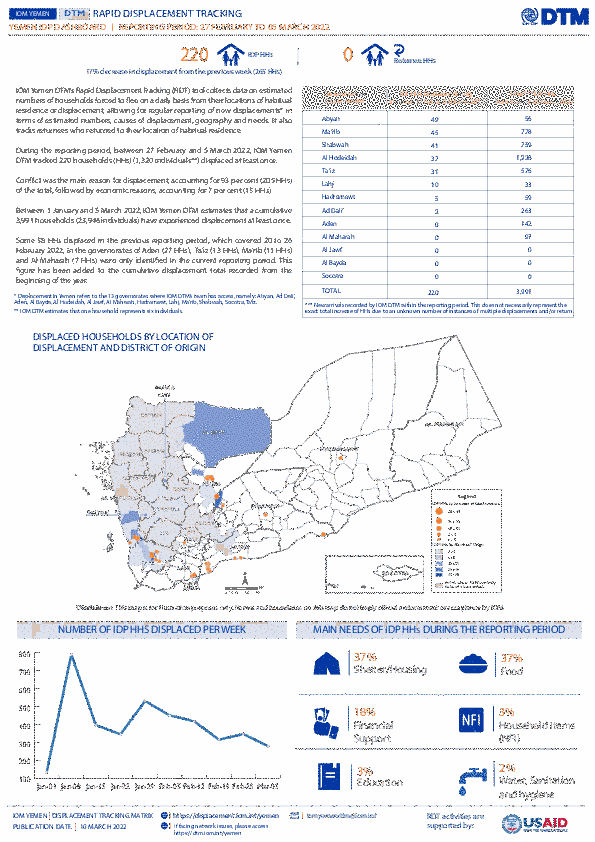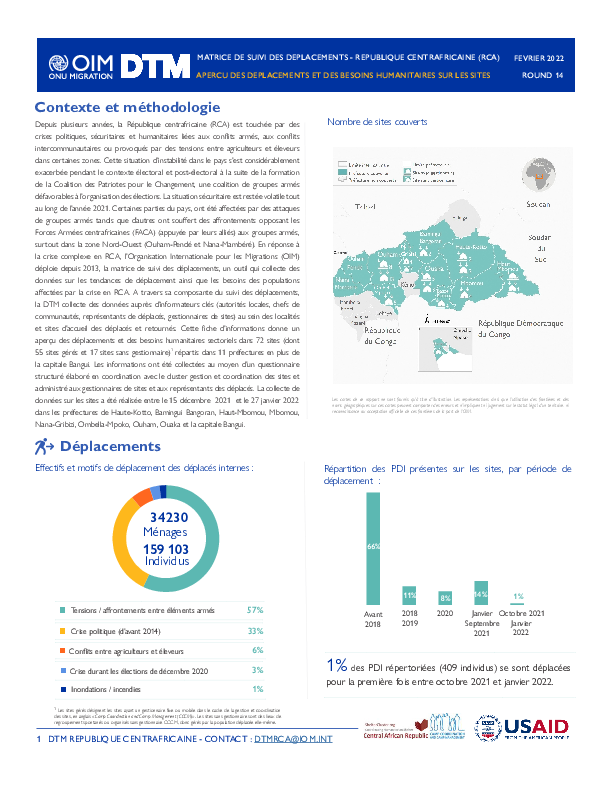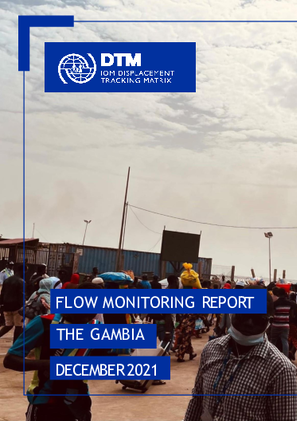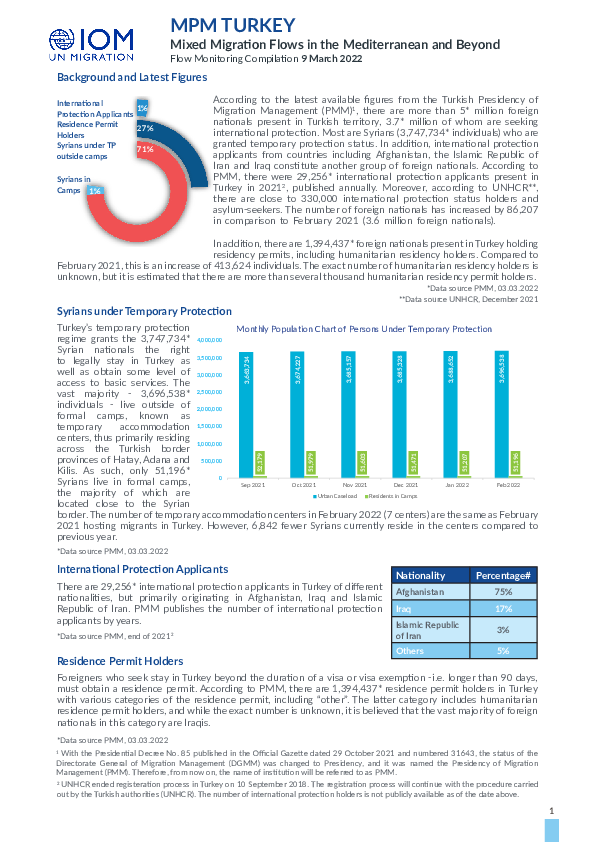-
Countries
-
Data and Analysis
-
Special Focus
-
Crisis Responses

Contact
DTM Yemen, iomyemendtm@iom.int
Language
English
Location
Yemen
Period Covered
Feb 27 2022
Mar 05 2022
Activity
- Rapid Emergency Registration
- Mobility Tracking
IOM Yemen DTM’s Rapid Displacement Tracking (RDT) tool collects data on estimated numbers of households forced to flee on a daily basis from their locations of origin or displacement, allowing for regular reporting of new displacements in terms of estimated numbers, geography, and needs. It also tracks Returnees who returned to their location of origin.
From 01 January 2022 to 5 March 2022, IOM Yemen DTM estimates that 3,991 households (HH) (23,946 Individuals) have experienced displacement at least once.
Since the beginning of 2022, DTM also identified 11 displaced households who left their locations of displacement and either moved back to their place of origin or another location.
Between 27 February and 05 March 2022, IOM Yemen DTM tracked 220 households (1,320 individuals) displaced at least once. The majority of people moved into/within the following governorates and districts:
- Abyan (49 HH) – Khanfar (49 HH) district. Most displacements in the governorate originated from Al Hodeidah.
- Marib (45 HH) – Marib City (31 HH), Marib (14 HH) districts. Most displacements in the governorate originated from Al Jawf and Marib.
- Shabwah (41 HH) – Ayn (19 HH), Ataq (11 HH), Radum (9 HH) districts. Most displacements in the governorate originated from Shabwah and Al Hodeidah.
The majority of people moved from the following governorates and districts
- Al Hodeidah (86 HH) – Hays (54 HH), Al Jarrahi (15 HH), Bayt Al Faqih (10 HH) districts.
- Taiz (43 HH) – Jabal Habashi (25 HH), Maqbanah (9 HH), Al Makha (2 HH) districts.
- Shabwah (25 HH) – Ayn (25 HH) district.
The Horn of Africa and Yemen is one of the busiest and riskiest migration corridors in the world travelled by hundreds of thousands of migrants, the majority of whom travel in an irregular manner, often relying on smugglers to facilitate movement along the Eastern Route. This regional report provides monthly updates on the complex migratory dynamics through Djibouti, Somalia, Yemen and Ethiopia based on diverse data sources and consultations with key informants in the four countries. Moreover, it provides information on the main protection concerns for migrants along the journey, information on the spill over effects of the conflict in Northern Ethiopia observed at the border between Ethiopia, Kenya and Sudan, a specific focus on children and information on the returns from Saudi Arabia to Ethiopia, Somalia and Yemen.

Contact
dtmrca@iom.int
Language
French
Location
Central African Republic
Period Covered
Dec 15 2021
Jan 27 2022
Activity
- Mobility Tracking
En réponse à la crise complexe en RCA, l’Organisation Internationale pour les Migrations (OIM) déploie depuis 2013, la matrice de suivi des déplacements, un outil qui collecte des données sur les tendances de déplacement ainsi que les besoins des populations affectées par la crise en RCA. A travers sa composante du suivi des déplacements, la DTM collecte des données auprès d’informateurs clés (autorités locales, chefs de communautés, représentants de déplacés, gestionnaires de sites) au sein des localités et sites d’accueil des déplacés et retournés. Cette fiche d’informations donne un aperçu des déplacements et des besoins humanitaires sectoriels dans 72 sites (dont 55 sites gérés et 17 sites sans gestionnaire) répartis dans 11 préfectures en plus de la capitale Bangui. Les informations ont été collectées au moyen d’un questionnaire structuré élaboré en coordination avec le cluster gestion et coordination des sites et administré aux gestionnaires de sites et aux représentants des déplacés. La collecte de données sur les sites a été réalisée entre le 15 décembre 2021 et le 27 janvier 2022 dans les préfectures de Haute-Kotto, Bamingui Bangoran, Haut-Mbomou, Mbomou, Nana-Gribizi, Ombella-Mpoko, Ouham, Ouaka et la capitale Bangui.

Contact
DTM Mali, DTMMali@iom.int
Language
French
Location
Mali
Period Covered
Nov 01 2021
Jan 31 2022
Activity
- Event Tracking
- Survey
- Flow Monitoring
Afin de mieux comprendre les tendances des mouvements transhumants et l’impact des fragilités sur les communautés transhumantes, l’OIM, à travers la Matrice de suivi des déplacements (DTM), a déployé depuis juillet 2021 et jusqu’au 31 janvier 2022 l’outil de suivi de la transhumance (Transhumance Tracking Tool - TTT) en collaboration avec l'ONG Tassaght, organisation pastorale membre du Réseau Bilital Maroobe (RBM) et bénéficiant d'une grande expertise quant au suivi des mouvements de transhumance au Mali.
Ce rapport presente les donnees recueillies entre novembre et janvier 2022 a travers les outils de comptage, alerte et enquetes detaillees du TTT au Mali.

Contact
DTM Niger, DTMNiger@iom.int
Language
French
Location
Niger
Period Covered
Jan 01 2022
Jan 31 2022
Activity
- Survey
- Flow Monitoring
Le suivi des flux de populations récolte des données sur les flux et tendances migratoires, les profils des voyageurs et les parcours et intentions des migrants, afin de fournir une meilleure compréhension des mobilités en Afrique de l’Ouest et du Centre.
Au Niger, la DTM recueille des données à 7 Points de suivi des flux (Flow Monitoring Point, FMP), dans le but d’identifier les zones à forte mobilité transfrontalière et intra régionale et récolter des données sur les tendances de mobilités et les profils et parcours des voyageurs dans le pays.
Ce rapport présente les données obtenues au travers des activités d’enregistrement des flux en janvier 2022.

Contact
RO Dakar, RODakar-DataResearch@iom.int
Language
English
Location
The Gambia
Period Covered
Dec 01 2021
Dec 31 2021
Activity
- Survey
- Flow Monitoring Survey
- Flow Monitoring
the Flow Monitoring tool collects data on migration flows and trends, traveller profiles, migration journeys and intentions of migrants in order to obtain a deeper view of mobility in West and Central Africa.
In The Gambia, DTM conducts Flow Monitoring activities at several important transit locations in:
1) Barra (FMPs are located at the ferry terminal and the main garage);
2) Farafenni (FMPs are located at Farafenni main garage, Farafenni Ballan-Ghar garage, Farafenni McCarthy and Sanjally garage, Farafenni turntable garage and the truck garage);
3) Basse (FMPs are situated at the main garage and the bus station in Basse Santa-Su) and
4) Brikama (FMPs are located at the main garage and the Bus station).
These activities enable DTM to monitor the movements of passengers within, out of and towards The Gambia as well as the movements of those passengers transiting The Gambia.
This report presents the key results from the Flow Monitoring Survey conducted from the 1st to the 31st of December 2021.

Contact
DTM Turkey, DTMTurkey@iom.int
Language
English
Location
Republic of Türkiye
Period Covered
Feb 01 2022
Feb 28 2022
Activity
- Flow Monitoring Survey
- Flow Monitoring
- Migrants presence
Mixed Migration Flows in the Mediterranean and Beyond - MPM TURKEY
Flow Monitoring Compilation 9 March 2022
According to the latest available figures from the Turkish Presidency of Migration Management (PMM)1, there are more than 5* million foreign nationals present in Turkish territory, 3.7* million of whom are seeking international protection. Most are Syrians (3,747,734* individuals) who are granted temporary protection status. In addition, international protection applicants from countries including Afghanistan, the Islamic Republic of Iran and Iraq constitute another group of foreign nationals. According to
PMM, there were 29,256* international protection applicants present in Turkey in 20212, published annually. Moreover, according to UNHCR**, there are close to 330,000 international protection status holders and asylum-seekers. The number of foreign nationals has increased by 86,207 in comparison to February 2021 (3.6 million foreign nationals).
In addition, there are 1,394,437* foreign nationals present in Turkey holding residency permits, including humanitarian residency holders. Compared to February 2021, this is an increase of 413,624 individuals. The exact number of humanitarian residency holders is unknown, but it is estimated that there are more than several thousand humanitarian residency permit holders.
*Data source PMM, 03.03.2022
**Data source UNHCR, December 2021
Contact
DTM Libya, DTMLibya@iom.int
Language
English
Location
Libya
Period Covered
Feb 01 2022
Feb 28 2022
Activity
- Site Assessment
- Mobility Tracking
Detention Centre Profiling is a component of IOM Libya’s Displacement Matrix programme. It is a data oriented tool that routinely provides specific sex and age demographic data and key sectorial information on individuals held in Libya’s detention centres on the date of assessment.

Contact
DTM Turkey, dtmturkey@iom.int
Language
English
Location
Republic of Türkiye
Period Covered
Feb 01 2022
Feb 28 2022
Activity
- Flow Monitoring Survey
- Flow Monitoring
- Migrants presence
According to the latest available figures from the Turkish Presidency of Migration Management (PMM)1, there are more than 5* million foreign nationals present in Turkish territory, 3.7* million of whom are seeking international protection.
Most of those seeking international protection are Syrians (3,747,734* individuals) who are granted the temporary protection status in Turkey. In addition, international protection applicants are most frequently nationals of Afghanistan, the Islamic Republic of Iran and Iraq constitute another group of foreign nationals. According to PMM, there were 29,256* international protection applicants present in Turkey in 20212, published annually. Moreover, according to UNHCR**, there are close to 330,000 international protection status holders and asylum-seekers.
In addition, there are 1,394,437* foreign nationals under residence permit holder status; this number includes humanitarian residence holders.
*Data Source PMM, 03.03.2022
**Data source UNHCR, December 2021

Contact
DTM Mauritania, DTMMauritania@iom.int
Language
French
Location
Mauritania
Period Covered
Dec 24 2021
Jan 07 2022
Activity
- Survey
- Migrants presence
- Mobility Tracking
La ville de Rosso, capitale administrative de la wilaya du Trarza est située au sud de la Mauritanie. Du fait de la position frontalière de la ville avec le Sénégal, elle constitue ainsi un point servant de relais entre les deux pays.
Le dynamisme économique, culturel et la position stratégique de la ville de Rosso en font une localité attirant des migrants en provenance de nombreux pays d’Afrique subsaharienne. Rosso est en effet une ville de destination de travailleurs migrants à la recherche d’emploi, tandis que sa position géographique favorise également le transit pour les migrants se dirigeant vers Nouakchott et Nouadhibou mais aussi vers l’Afrique du Nord ou l’Europe.
Ainsi, une meilleure connaissance de la population migrante à Rosso, de leurs profils et besoins permet de mieux concevoir et suivre des programmes visant l’appui de cette population ainsi qu’aux autorités nationales.
C’est dans ce cadre que s’inscrit l’organisation de cette enquête réalisée à Rosso conjointement par l’Agence Nationale de la Statistique et de l’Analyse Démographique et Économique (ANSADE) et l’Organisation Internationale pour les Migrations (OIM). Son but est de mieux comprendre le phénomène migratoire à Rosso (dynamiques, profils ampleur et besoins migratoires) afin de planifier une réponse appropriée comprenant des filières d'orientation appropriées pour les personnes ayant des besoins spécifiques.
Ce présent rapport est consacré aux résultats de l’enquête migration réalisée dans la ville de Rosso du 24 décembre 2021 au 07 janvier 2022.
